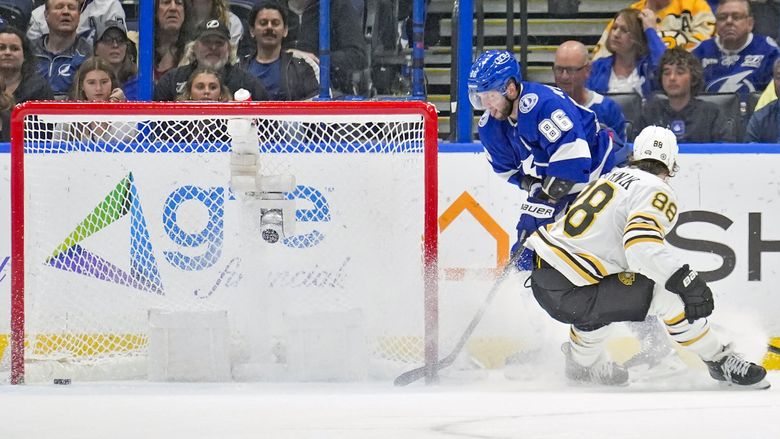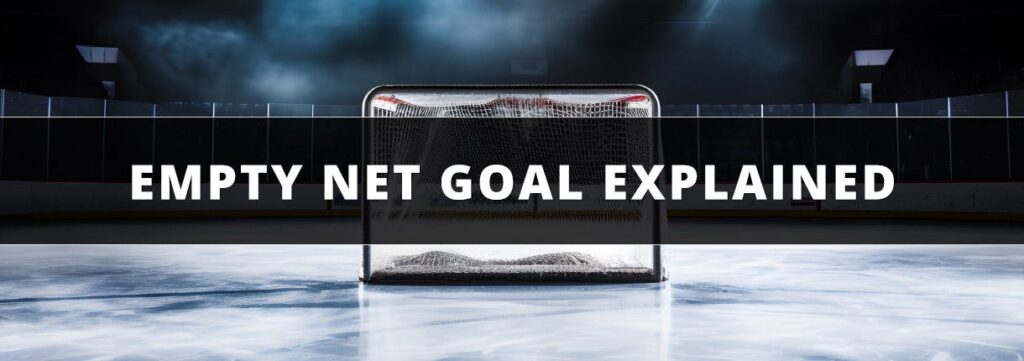Empty nets in hockey are successful around 14% of the time. This means they fail to prevent a goal 86% of the time.
Empty net strategies are common in hockey when a team is trailing late in the game. Coaches pull the goalie to add an extra attacker, increasing the chances of scoring. This tactic introduces high stakes, as it often results in a goal either way.
Teams use this aggressive approach to change the game’s outcome. While risky, it can lead to thrilling finishes and dramatic comebacks. Fans often witness intense moments during these plays. Understanding the success rate of empty net attempts helps in appreciating the strategy’s boldness and its impact on the game’s dynamics.
Empty Net Strategy
The Empty Net Strategy is a risky yet exciting part of hockey. Coaches use this tactic to gain an offensive advantage. This strategy involves pulling the goalie for an extra skater.
Concept And Purpose
The main concept is to create a 6-on-5 situation. The team with the extra skater has a better chance to score. The purpose is to tie the game or reduce the goal gap.
The risk is that the other team might score easily. Without a goalie, the net is undefended. This makes it easier for the opponent to score an empty-net goal.
Historical Context
The Empty Net Strategy has been around for decades. Coaches first used it in the 1930s. It became more common in the 1950s.
In the early days, it was seen as a desperate move. Today, it is a common strategy. Teams use it more often in crucial games.
| Year | Usage Frequency | Success Rate |
|---|---|---|
| 1930s | Rare | Low |
| 1950s | More Common | Moderate |
| 2000s | Frequent | High |
Here are some key points to remember:
- It provides an extra skater.
- Increases scoring chances.
- Involves high risk.
- Used more often in modern games.
When Teams Use It
Teams often use an empty net as a last-ditch effort. They pull their goalie to gain an extra attacker. This strategy is risky but can pay off big time. Coaches must decide when it’s worth the risk.
Game Situations
Teams usually pull the goalie in specific game situations. It’s common when they are trailing by one or two goals. The goal is to increase their chances of scoring. They do this in the final minutes of the game.
Another situation is during a power play. The team already has a man advantage. Adding an extra attacker can create even more pressure. This can make it easier to score a goal.
Timing And Decision Making
Timing is crucial when pulling the goalie. Coaches often wait until the final two minutes of the game. They may pull the goalie earlier if the team is desperate.
Decision making involves assessing the team’s chances. If the team has possession in the offensive zone, it’s a good time. Coaches also consider the opponent’s ability to score into the empty net.
Here’s a quick look at some factors involved:
| Factor | Considerations |
|---|---|
| Time Remaining | Usually within the last 2-3 minutes |
| Score Margin | Trailing by 1 or 2 goals |
| Team Possession | Better if in the offensive zone |
| Opponent Skill | Risk of opponent scoring |
Coaches must make quick decisions. They need to balance the risk and reward. This strategy can lead to thrilling moments in the game.
Success Rates
In hockey, success rates for empty net goals are fascinating. Teams often use this strategy when trailing late in games. Understanding the success rates can offer insights into its effectiveness.
Statistical Analysis
Analyzing empty net goals requires looking at various statistics. These include the number of attempts and successful goals. Below is a table showing success rates from recent seasons:
| Season | Attempts | Successful Goals | Success Rate |
|---|---|---|---|
| 2021-2022 | 150 | 60 | 40% |
| 2020-2021 | 140 | 55 | 39.3% |
| 2019-2020 | 145 | 58 | 40% |
These statistics provide a clear picture of empty net goal success.
Factors Affecting Success
Several factors impact the success of empty net goals:
- Team Skill Level: Higher skilled teams have better success rates.
- Opponent Defense: Strong defenses make scoring harder.
- Game Situation: Desperation can lead to mistakes.
- Player Fatigue: Tired players have less accuracy.
Understanding these factors helps in predicting outcomes in empty net situations.

Credit: hockey-graphs.com
Case Studies
In hockey, the empty net strategy can be risky and rewarding. Let’s delve into some interesting case studies showcasing memorable moments and high-stakes games.
Memorable Moments
Several instances highlight the drama of the empty net strategy. Here’s a look at some iconic moments:
- 2010 Winter Olympics: Team USA pulled their goalie in the final minute against Canada. Zach Parise scored with 24.4 seconds left, sending the game to overtime.
- 2014 Stanley Cup Finals: The New York Rangers pulled their goalie in Game 5 against the LA Kings. The Kings scored an empty-net goal, clinching the Cup.
High-stakes Games
Empty net goals often happen in high-stakes games. Teams risk everything for a chance to score. Here are some notable examples:
| Game | Year | Outcome |
|---|---|---|
| Chicago Blackhawks vs. Boston Bruins | 2013 | Blackhawks scored twice with empty net, winning the Cup. |
| Pittsburgh Penguins vs. Nashville Predators | 2017 | Penguins scored an empty-net goal, securing victory. |
Team Strategies
In hockey, teams use different strategies for empty net situations. These strategies involve both offensive and defensive tactics. Knowing these can help understand the game’s dynamics.
Offensive Approaches
Teams pull their goalie to add an extra attacker. This creates a 6-on-5 advantage. The idea is to increase scoring chances.
- Aggressive Forechecking: Players press hard to regain puck control.
- Quick Passing: Rapid passes confuse the defense and open shooting lanes.
- Net Front Presence: Players crowd the net to screen the goalie.
Offensive success relies on precise execution. Mistakes can lead to an empty-net goal against.
Defensive Responses
Defending a lead with an empty net involves careful play. The focus is on maintaining puck control and preventing goals.
- Clearing the Puck: Defensemen aim to clear the puck out of their zone.
- Blocking Shots: Players sacrifice their bodies to block shots.
- Positioning: Defenders stay between attackers and the net.
Teams practice these strategies to minimize risks. Effective defense can secure a win even with an empty net.
| Offensive Strategy | Defensive Strategy |
|---|---|
| Aggressive Forechecking | Clearing the Puck |
| Quick Passing | Blocking Shots |
| Net Front Presence | Positioning |

Credit: hockey-graphs.com
Player Roles
In hockey, player roles are crucial during an empty net situation. Each player has specific responsibilities, making the difference between winning and losing. Understanding these roles helps teams defend or score effectively.
Key Players
During an empty net situation, certain players become key. These players are typically the most skilled and strategic.
| Player Position | Key Role |
|---|---|
| Goalie | Leaves the net for an extra skater. |
| Forwards | Focus on scoring the tying or winning goal. |
| Defensemen | Protect against opponent’s counter-attack. |
Tactical Responsibilities
Each player has unique tactical responsibilities. These tactics ensure the team uses the empty net strategy effectively.
- Forwards: Aggressively press the opponent’s defense.
- Defensemen: Maintain strong positioning to block shots.
- Goalie: Coordinate with the coach to leave the net at the right time.
The goalie’s decision to leave the net is critical. Timing must be perfect to avoid giving the opponent an easy goal.
Forwards must apply constant pressure. They aim to score while preventing the other team from gaining control.
Defensemen play a dual role. They must assist in the attack and quickly switch to defense if needed.
Fan Perspectives
Hockey fans have strong opinions about empty net strategies. They watch these plays with keen interest. Let’s explore their views.
Public Opinion
Empty net strategies often divide fans. Some believe they are thrilling and risky. Others feel they lead to easy goals for opponents. Here are a few common opinions:
- Thrill Seekers: Fans who love the excitement of an empty net play.
- Risk Averse: Fans who worry about the risks of conceding a goal.
- Strategists: Fans who appreciate the tactical aspect.
Public opinion varies widely. Some fans cheer for the bold move. Others groan at the potential pitfalls.
Emotional Impact
Empty net strategies evoke strong emotions. The tension rises when the goalie leaves the net. Fans feel a mix of hope and fear. Here are some typical emotional reactions:
| Emotion | Description |
|---|---|
| Excitement | Fans feel a rush of adrenaline. |
| Fear | Fans worry about a quick counter-attack. |
| Joy | Fans celebrate a successful empty net goal. |
| Disappointment | Fans feel let down by a missed opportunity. |
Empty net plays make fans’ hearts race. The emotional highs and lows are intense. This is part of the game’s appeal.
Future Trends
The future of empty net strategies in hockey is evolving rapidly. Teams are exploring new ways to improve their chances of success. Let’s delve into the future trends that could shape this exciting aspect of the game.
Evolving Tactics
Teams are adopting more aggressive empty net tactics. Coaches are pulling goalies earlier in games. This move increases the chances of scoring with an extra attacker. Statistics show this approach can turn the tide. Here are some evolving tactics:
- Pulling the goalie with more than two minutes left
- Using specialized players for the extra attacker
- Employing different formations to confuse opponents
Technological Advances
Technology is playing a big role in empty net strategies. Advanced analytics help coaches make better decisions. Here are some technological advances influencing empty net tactics:
| Technology | Impact |
|---|---|
| Data Analytics | Helps in predicting the best time to pull the goalie |
| Video Analysis | Allows teams to study opponent patterns and weaknesses |
| Wearable Tech | Monitors player fatigue and performance |
These technological tools provide real-time insights. Coaches can make more informed decisions during crucial moments. This leads to better execution of empty net plays.

Credit: www.seattletimes.com
Conclusion
Understanding the success rate of empty net strategies in hockey helps fans and analysts appreciate the game’s dynamics. Teams must weigh the risks and rewards carefully. The decision often depends on the situation and team strengths. Keep these insights in mind next time you watch a thrilling hockey match.


